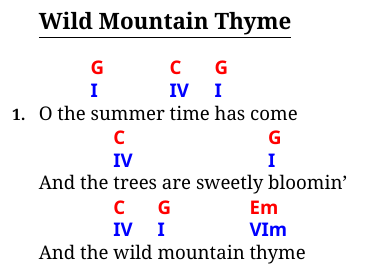Notation and Transposition
For the purpose of transposition, Bard supports these four notation systems:
The English notation is the default.
If you live in, for example, central Europe or Scandinavia, you may want to set notation = "german" in your bard.toml.
However, if you don’t use transposition features, you don’t need to worry about this; Bard will simply use whatever you enter as chords. Correct notation setting is only needed when using transposition so that Bard can understand the chords you are using.
Transposition
To transpose your chords, use the !±X syntax, where X is the number of halftones.
The chords will be transposed from that point onward. For example:
# Danny Boy
!+5
1. `G7`Oh Danny `C`Boy, the pipes, the ``C7``pipes are `F`calling
will shift the chords up by 5 halftones, aka perfect fourth:

If needed, use !+0 to go back to the original scale.
Second Set of Chords
Bard can also generate a second line of chords as a transposition of the first one.
Use the !!±X syntax to generate a second row. The second row is, by default,
rendered in blue font. For example:
# Danny Boy
!!+5
1. `G7`Oh Danny `C`Boy, the pipes, the ``C7``pipes are `F`calling
renders as:

Notation Conversion
Besides transposition, the notation system of chords can also be converted using the !notation syntax,
where notation is one of the names listed above in lowercase.
This can be used just like transposition (and together with it) as well as for the second line of chords.
A comprehensive example of transposition and notation conversion to generate a ‘scale agnostic’ second line:
# Wild Mountain Thyme
!!-7
!!roman
1. O the `G`summer `C`time `G`has come
And the `C`trees are sweetly `G`bloomin'
And the `C`wild `G`mountain `Em`thyme
